On the glass doors at the front entrance of Clark College, posters proclaiming the school's inclusive community welcome visitors, describing a place free of discrimination and harassment. But inside the campus walls, teachers, staff and students tell a different story.
“It’s not a climate that feels safe for you to really thrive,” said Summer Brown, Clark College’s only black counselor, who quit her tenure-track position in March.
She’s one of seven prominent women of color who has left the Vancouver, Washington, community college in the past year alone. School records and dozens of interviews with staff and students conducted by OPB show a culture at Clark College that alienates people of color, even as top school officials say the campus is becoming more inclusive.

Summer Brown was Clark College's only black counselor. She left her tenure position in March because of what she considered a toxic work environment for people of color.
Contributed by Summer Brown
During an interview at her private practice for marriage and family therapy in Hazel Dell, Brown described a work environment at Clark College that was particularly harmful to women of color. In the months before she decided to leave, she said she felt like she was constantly being monitored by her supervisors. Brown described her bosses scrutinizing everything, from the number of students she saw per day to the time spent during her lunch break.
“I had to work to make my own space at Clark, every second of every day,” Brown said. “I had to work extra to be seen, acknowledged.”
Brown said there was a lot she was proud of during the two years she worked at Clark College. She helped set up the school’s first sex education fair and organized events around LGBTQ identity. As a self-described queer, black woman, Brown’s passion was to create safe spaces on campus for underrepresented voices.
“I was really jazzed about some of the projects I was working on at Clark,” she said, but added that she quickly felt “burnt out because of the climate.”
Brown recounted passive aggressive emails from her mostly white coworkers and how she had to fight to get a person of color on her tenure committee. The incidents never felt like a smoking gun. They were subtle, which sometimes made them easier to brush off.
She remembers on numerous occasions, Clark College President Bob Knight would call her and other employees of color troublemakers. Knight said he regrets using the term and that he had always thought of it as a playful tease.
“When I see people on campus, whether they’re people of color or other, that I feel like I’m comfortable with and I say, ‘Here comes trouble,’ it’s more of an affectionate term — the way I looked at it,” Knight told OPB.
He said in the 12 years he’s worked at Clark, he never thought about how the phrase might sound to employees of color coming from a white man.
“You gotta be careful with your audience,” he said. “And again, it’s part of that power and privilege that I carry. Sometimes the things I say can be taken differently than I intended, so I have to be aware of that.”
Over time, these incidents piled up and began to spill into Brown’s personal life. She started having regular panic attacks and was losing sleep.
“It stopped being a safe space for me,” she said. “And it wouldn’t surprise me if that was other people’s experience as well.”
As it turns out, Brown wasn’t alone.
Mixed Messages
Six other women of color also left the school last year, including three employees from the college’s diversity center. One of the first to leave in the wave of departures was Felisciana Peralta, the former director of student inclusion and equitable services. She resigned from her position last September.
“It became a hostile work environment, and I felt like it was no longer in line with my values and my integrity,” said Peralta, who was instrumental in creating a campus diversity center. “It was hard to walk away from a place I helped build.”
Peralta has remained on campus as an adjunct professor at Clark but has stepped away from diversity work there. After nearly a decade at the college, she was twice passed over for a leadership position to run the department. She’s now the director of diversity, equity and inclusion at Mt. Hood Community College.
“I believe that there is a problem at Clark or there wouldn’t be so many leaving,” she said.
Peralta said a lot of her frustrations stemmed from new leadership at the office of diversity and equity. Last fall, Loretta Capeheart became the college’s first associate vice president of diversity, equity, and inclusion, a job that Peralta was also a finalist for.
Peralta described a shift once Capeheart stepped into the role. She introduced policy changes and rules that Peralta and others told OPB they felt were unnecessary and disrupted the culture at the center.
“When Loretta got there, everything changed,” said Roslyn Leon Guerrero, an employee at the diversity center who quit shortly after Peralta.
Rules banning food in the center were enforced and students were encouraged to stop using the kitchen area, a place that had previously been a source of community building and potluck events. Student peer mentors who worked at the diversity center were moved into a different building across campus.
“Before, it was a safe place where students could really express themselves, meet up for a meal, get help tutoring,” Guerrero said. “But, it soon became very restricted and the morale really went down.”
Peralta said there was also a significant change in how the Office of Diversity and Equity implemented the school’s social equity plan. Peralta and her coworkers had always been very engaged in the community, showing up at student events, promoting the college at job fairs, and organizing multicultural events on campus.
Now, Peralta said, Capeheart told her to stay behind her desk.
“I felt like leadership was aggressively trying to block me from doing my work,” Peralta said. “A lot of people have left because they feel unheard and undervalued.” Not long after Peralta quit, two other employees at the diversity center — Dolly England and Guerrero — also handed in their resignations.
'Who Can I Run To?'
Students of color at Clark make up nearly 40 percent of the student body, and they said they noticed the resignations.
“Who can I run to and talk about my day now? The whole thing just makes me feel sad,” said Kenon McCollins, a 27-year-old student who enrolled at Clark College in 2016 after finishing a contract with the U.S. Marine Corps.
At Clark, he wanted to find direction in his life after the military, a club or a student group that centered on his identity as an African-American.
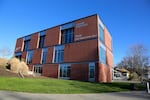
Clark College in Vancouver, Washington.
Molly Solomon / OPB
“I went to the diversity center and I spoke with Dolly. She was a black woman, and I just said, ‘Hey, I need to build community,’” McCollins said, referring to Dolly England, the college’s former diversity outreach program manager. “She just understood where I was coming from.”
England took McCollins under her wing during his first week and brought him to a job fair centered on hiring African Americans. She also told him about the Black Student Union and encouraged him to get involved. Soon after, he became their vice president.
“She went above and beyond. I love her for that,” he said.
Seeing the recent departures of faculty of color has left McCollins feeling deflated and concerned that students like him will have a harder time getting support at the college.
“Once you see a strong leader like Dolly leave, and then you look around and see all these women of color left,” he said, “it makes you feel depressed.”
McCollins graduated from Clark College in June with an associate’s degree in communication. He said he has mixed feelings about his time at Clark. Protesting helped him find his voice. But, he said, it was also exhausting.
“I shouldn’t have been fighting racism and all those oppressions at Clark. I should have been focusing on schoolwork,” he said.
A History Of Problems
While the recent departures have had a significant effect on Clark students like McCollins, they are only the latest turn in an extended struggle with inclusion at the school.
In 2010, a student at Clark distributed a series of flyers proclaiming white pride. One of them was handed to Lexi Peterson-Burge, who was a 16-year old high school student at the time taking college courses through a program called Running Start. It was her third week of classes when a man she didn’t know approached her.
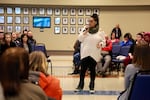
Clark College student Lexi Peterson-Burge speaks about her own experiences of racism at the school during a community forum in response to racist flyers.
Molly Solomon / OPB
“He had swastika tattoos all over him: on the tops of his hands, on the back of his head, his head was shaved,” Peterson-Burge recalled recently. She’s now back at Clark to finish her associate’s degree.
The flyer was a one-page handout with “White and Proud” scrawled across the top. On the bottom was a contact for the local National Socialist Movement, one of the largest neo-Nazi groups in the United States.
The man smirked at Peterson-Burge, who is black and Native American, when he handed her the flyer. She knew why she was targeted.
“Because I was brown,” she said. “That was the intention.”
Peterson-Burge said the harassment didn't stop with the flyer, however.
“What ended up happening in the weeks after that was that brown people on campus were being targeted,” she said.
Guerrero, the former Clark College diversity center employee who recently left, remembers also being intimidated when she was taking classes at the school that year. Guerrero reported a group of white men pushing her late one evening after class. One of the men said that people like her were a problem, and yelled “you colored people suck.” Guerrero ran to her car and called security three times, she said, but nobody answered. The next morning, she was so shaken that she had her brother-in-law walk onto campus with her to file a report.
“People were getting their backpacks ripped off of them, shoved into cars,” Peterson-Burge said. “It got to the point where security wasn’t responding enough when things were happening so we started walking to classes in pairs, especially women of color.”
For Bob Williamson, Clark College’s vice president of administrative services, those incidents were a wake-up call.
“It has clearly come to the college's attention that we have students and faculty who feel threatened or unsafe or unwelcome almost every day,” he told OPB’s "Think Out Loud" in 2010 after the flyers went up.
Campus security removed the flyers within 48 hours.
But many on campus weren't satisfied. An initial campus-wide email reaffirming the school's non-discrimination policy was sent two days later by the vice president of human resources, a decision that was sharply criticized by faculty and students like Peterson-Burge because they thought campus President Bob Knight should have been the one responding.
“It was really, really, really minimal. And it wasn’t sufficient,” Peterson-Burge said. “Especially for the students that were affected personally by it. And historically, that’s how Clark has been any time there’s a situation.”
Knight did talk about the flyers two weeks later at a regularly scheduled campus meeting. He apologized, but told The Columbian he didn't act sooner because "I just didn't feel that it was warranted."
The student who had originally distributed the fliers also showed up at that meeting. Wearing a navy uniform emblazoned with a swastika, he read his flyer out loud to the room of students and faculty.
A month later, a second set of racist fliers from the student was allowed to stay up. The school’s attorney cited freedom of speech and said its hands were tied.
'Hate Will Flourish'
“If leadership is not supportive, if they are not active in creating a different kind of environment, then hate will flourish,” said Earl Ford, former president of the Vancouver NAACP.
Ford said the Clark College’s executive cabinet has not taken a hard enough stance against hate activity on campus.
And he’s worried history may be repeating itself.
Earlier this year, “it’s OK to be white” and anti-Semitic flyers appeared on campus. Many were taped outside the school’s diversity center. And in March, Ndeye Astou Cisse, president of the school’s Black Student Union, was walking across campus when she was met with a slew of racial slurs from a car full of white men.
“It’s like its ghosts from the past that have just not left yet. They can’t get rid of them,” said Kathy Bobula, a retired Clark College professor who taught early childhood education and psychology for 31 years at the school.
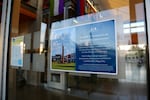
A flyer with Clark College's non-discrimination policy hangs on several doors and classrooms on campus.
Molly Solomon / OPB
Bobula is one of 14 current and former Clark College employees who spoke with OPB about patterns of workplace diversity issues. Many spoke on background and did not wish to be included in the article out of fear of retribution by employers.
Former employees like Bobula said the climate at Clark has been hostile toward people of color for some time. She used to serve as the affirmative action officer at the college and says there was a lot of resistance toward hiring people of color.
“Clark had a lot of leftovers from the past for quite a long time, people who worked there who I considered carried significant biases,” said Bobula.
She remembers sitting in on a hiring meeting for a groundskeeper position. The two finalists had similar qualifications, but one was Native American. As the affirmative action officer, Bobula urged the personnel team to hire the diverse candidate — but they opted to go with the other person, a white man. According to Bobula, one of the people on the hiring team turned to her and said, “We’ve already got an Indian.”
“There was not a diverse staff there because they absolutely made sure there wasn't a diverse staff there,” she said. “And the thing is, it never got better.”
Bobula was sad to hear that seven women of color had left Clark in the past year.
“It’s phenomenally big, it’s horrible,” she said. “I think it should trigger the board to take a look at what in the heck is going on there.”
Effect On Students
Clark College serves around 13,000 students across Clark, Skamania and Klickitat counties. The diversity issues at the college — from racist propaganda to staff turnover — are crucial because of who makes up that student body.
Unlike four-year universities, community colleges are more accessible to everyone. More than 70 percent of the students at Clark are the first in their family to go to college. And nearly half qualify as low income.
“Community colleges are in many ways on the front lines of equity work,” said Joshua Todd, executive director with Campus Compact of Oregon, a nonprofit that helps higher education institutions better serve a diversifying workforce and student body.
“The student body at community colleges is often more diverse, and in many communities, they’re the only game in town,” Todd said. “But that doesn’t mean they’re not struggling with finding, retaining, and promoting faculty that represent their student body.”
Faculty and staff of color make up less than 14 percent of employees at Clark College. That’s far behind the racial makeup of the student population, which is 39 percent people of color.
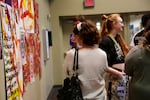
Students responded to racist incidents on campus and the departure of several women of color by putting on an art show in May called "Living Targets."
Molly Solomon / OPB
Shanda Diehl, associate vice president of planning and effectiveness at Clark College, said diversity recruitment numbers have gone up over time, but the college has a lot to do when it comes to making sure employees of color stay.
“What we’re trying to see, of the people who we recruited in, were we able to keep them?” Diehl said.
She said the college started tracking its retention numbers in 2015. But even in that short time frame, Diehl said they’re starting to see a disturbing trend: Employees of color don’t last as long as their white co-workers. In 2015, nearly 40 percent of black employees had left within a year of being hired.
“The reality is, and you can see in this data, we have a revolving door among our employees of color,” Diehl said.
The college has also been hit with several discrimination lawsuits from former employees, who said they were treated unfairly because of their race, age or gender. Three settlements within the last 15 years reviewed by OPB show Clark College has paid out nearly half a million dollars because of discrimination. Another case that alleges racial discrimination in the tenure process is still pending.
“By having a revolving door in this particular way, it can promote a place that feels more traumatizing than healing and supportive,” said Sonali Sangeeta Balajee, a senior fellow at UC Berkeley’s Haas Institute.
She has a background in equity work and says community colleges have a duty to foster diversity.
“It disrupts the possibility of supportive relationships for students of color if you see a large number of people of color leaving an institution all at once,” she said.
School Response
All of this is on the board’s radar, according to Clark College President Bob Knight. School administrators talk regularly about ways they can recruit more people of color.
Last September, in a presentation to the board, Loretta Capeheart, the associate vice president of diversity, spoke about plans to create an employee retention strategy. And in April, Knight’s report to the board included a mention that several employees of color had recently left the school. He said he planned to meet with employees and students to hear their concerns.
Over the course of several interviews, Knight highlighted progress Clark has made: The school’s strategic plan includes social equity as a core theme; the school recently moved a diversity and equity advisor to a cabinet-level position; in 2012, Clark opened the campus diversity center.
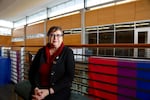
Loretta Capeheart ran the Office of Diversity and Equity at Clark College. She was let go last month after a string of resignations from women of color on campus.
Molly Solomon / OPB
And the number of employees of color at the college has gone up 5 percent in the last decade. Knight said when he started in 2006, there was only one African American tenured professor at the college. Now, he said, there are five.
“Is that a lot? No it’s not. But we’re making these incremental strides,” Knight told OPB. “We’re going through the bumps and bruises of what it is when you try to diversify a workforce. but the leadership at Clark is committed and the data shows we’re moving in the right direction.”
Knight said this focus on diversity work came out of feedback from an anonymous employee “climate survey,” that is collected every other year. Looking at the data, he said, it was clear they had a problem. Comments in the most recent survey called the college’s efforts to be more inclusive nothing more than “lip service” and that there was “plenty of talk, but little action.” Others criticized the lack of diversity in staff and leadership positions and said people of color were not treated equally. One person called Clark “the college equivalent of Wonder Bread.”
But Knight said the idea that people of color are leaving the school because of diversity issues is a false narrative. The people who were gone had left for other reasons, he said, like finding better-paying jobs elsewhere.
“What you’re hearing from is a few vocal minorities,” Knight said. “But I think in general people of color are content here.”
In July during the reporting of this story, Knight abruptly let go Capeheart, Clark College’s vice president of diversity, equity and inclusion. In a campus-wide email, Knight thanked Capeheart for moving the college’s social equity plan forward and announced she would be working off-campus until her contract expired Sept. 30.
Capeheart, also a woman of color, had been in the position less than a year. Knight called the decision a personnel issue but said issues with diversity became clearer to him soon after his interview with OPB.
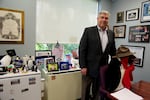
Clark College President Bob Knight in his office on campus.
Molly Solomon / OPB
When reached by phone recently, Capeheart said she was completely blindsided by the firing. She called Knight a "coward" and said he gave her no explanation.
“It seems clear that there's a personal vindictiveness on the part of President Knight that can be very damaging to people,” Capeheart said, “whether he realizes it or not.”
Capeheart said leaving the highest position dedicated to diversity and inclusion open will have damaging effects on the school’s commitment to social equity.
“The continual churning in that seat means nothing has been done,” she said.
At the start of the school year, Clark College announced two hires to the executive cabinet, Stefani Coverson as the vice president of human resources and compliance and Dr. Sachi Horback as the vice president of instruction. Both Coverson and Horback are women of color, and make up the most diverse cabinet Clark has had in nearly a decade.
What many will be watching closely now is how long they stay.
